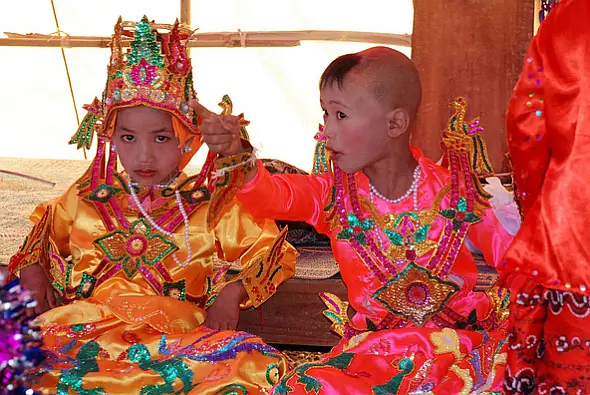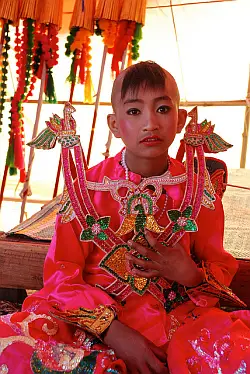Rites of Passage in Myanmar's Tribal Highlands — Page 2
Story and photos by Michael Shapiro

At the hilltop village we see a young man with a horn so long it stretches like a 10-foot checkmark on the ground. Others villagers play big drums and gongs, but at times the ancient music is obliterated by distorted Burmese pop songs blasting through gargantuan speakers.
The ceremony is held under a large tent supported by bamboo poles with golden curtains and dozens of Buddhist flags fluttering around the edges. About 100 villagers sit on tarps under the canopy, eating fried peanuts, garbanzo beans and tea-leaf salad while sipping tea.
The seven monk initiates squirm on a makeshift stage. Village elders present them with papers in the ancient Pali language that contain instructions about how to don their robes. Money for the novices is collected in hammered silver bowls or slipped to them in international airmail envelopes with a red, white and blue border.

The novices are wearing their gaudy robes and kaleidoscopic crowns when senior monks arrive to guide the ceremony. But not everyone pays attention to the ritual: Young men in leather jackets with slicked-back hair stand outside watching videos on their cell phones. Older men in tattered army jackets smoke or chew betel, their teeth stained reddish brown from the leafy intoxicant.
The women under the tent recognize us and, with betel-stained grins, wave us in. One grandmother offers us tea and a plate with fried shredded ginger and peanuts so we can nibble while we watch the incantations and rituals onstage.

Becoming Bald and Blessed
The boys seem restless — they've been on the podium for hours and aren't sure what awaits them. Some will stay at the monastery for just a week, others may serve for a year or more. An eight-year-old boy named Swan Htet Thu says: "I am happy today, I like wearing this costume."
He will stay at the monastery only five days and then return to his family.
The monastery is the village's social safety net; some kids ends up as monks because their parents are absent or unable to care for them, and at the monastery these children are fed, clothed and educated.
After a series of chants an elder monk calls the boys forward, asks them to remove their Siddhartha costumes and takes a barber's electric razor to their hair. As each boy's head is blessed with holy water, the long black strands fall to the ground. One of the younger boys starts crying. After the boys' heads are shaved clean, the consecrated water is poured back into the Earth.
This made me think about the similarity of traditions: the holy water shared by Buddhism and Christianity. And seeing the boys get their heads shaved and then given uniforms is akin to the way the U.S. initiates people into military service.
The boys must formally ask the elder monks if they can become novices. A monk asks each initiate if he will honor the Buddha and study his teachings. He also asks each boy if he understands the teachings. If the boy says no, he won't become a novice.

Each boy says yes to all the questions and a long white piece of fabric is passed among them, knitting them together. The cloth symbolizes the boys' connection to the Buddha, the Dharma (teachings) and the Sangha (community).
The novices aren't quite sure how to get into their robes, but their uncles and monks move in to show them. Dressed in their burgundy attire, they squat and chant repeatedly: "I believe in the Buddha, I believe in the teachings of Buddha, I believe in the monks."
The elder monks seem austere but the kindness in their eyes suggests the boys will be well cared for. In another tent of sorts, families dine together on a meaty stew cooked outdoors in large pots over wood fires. For the boys' families, it will be their final meal with their sons for a while.
And then it's time for a final procession: accompanied by the monks, the boys re-mount their horses and clip-clop through Kalaw's narrow streets en route to the monastery that will be their new home. As we leave, we catch a last glimpse of the procession and see the two young girls, the popcorn throwers we'd met coming into town. We wave and they smile; then they bashfully turn away, laughing.
Michael Shapiro is the author of A Sense of Place and wrote the text for the pictorial book, Guatemala: A Journey Through the Land of the Maya featuring photographs by Kraig Lieb. His travel writing has appeared in National Geographic Traveler, American Way and Islands magazines, and the travel sections of the Washington Post, San Francisco Chronicle and Los Angeles Times. His story about rafting down the Grand Canyon in the wake of John Wesley Powell appears in The Best Travel Writing 2011.
Related stories:
On a Slow Boat down the Irrawaddy River by Jim Johnston
A Capital Built for Kings and SUVs by Robert Reid
Slipping Through Doors & Gates in Burma by Michael Buckley
Finding Old Ireland Alive in Place, Words, and Song by Michael Shapiro
See other Asia travel stories from the archives
Copyright (C) Perceptive Travel 2014. All rights reserved.
- Dance of Betrayal in Nairobi by Camille Cusumano
- Harvesting the Spirit of Cannabis in the Pacific Northwest by Becky Garrison
- World Music Reviews
- Travel Book Reviews
Books from the Author:

Order Guatemala: a Journey Through the Land of the Maya through your local bookstore or get it online here:
Amazon US
Amazon Canada
Amazon UK
Fishpond (Australia)

Buy A Sense of Place at your local bookstore, or get it online here:
Amazon US
Amazon Canada
Amazon UK
Fishpond (Australia)

